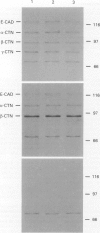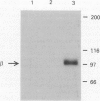Abstract
All-trans-retinoic acid (RA), like insulin-like growth factor I (IGF-I) and tamoxifen, inhibit invasion of human MCF-7/6 mammary cancer cells in vitro. For tamoxifen and for IGF-I, activation of the invasion-suppressor function of the E-cadherin/catenin complex was shown to be the most probable mechanism of the anti-invasive action. We did a series of experiments to determine whether the anti-invasive effect of RA also implicated the invasion-suppressor E-cadherin/catenin complex. Human MCF-7/6 mammary and HCT-8/R1 colon cancer cells, both with a dysfunctional E-cadherin/catenin complex, were treated with RA and the function of the complex was evaluated through Ca(2+)-dependent fast aggregation. Fast aggregation of both MCF-7/6 and HCT-8/R1 cells was induced by 1 microM RA. This effect was abolished by antibodies against E-cadherin. RA-induced fast aggregation was not sensitive to cycloheximide, tyrosine kinase inhibitors or antibodies against IGF-I or against the IGF-I receptor. RA did not stimulate IGF-I receptor phosphorylation or alter the E-cadherin/catenin complex, as evidenced by immunoprecipitation. RA up-regulates the function of the invasion-suppressor complex E-cadherin/catenin. Its action mechanism is different from that of IGF-I. RA may act as an anti-invasive agent with unique mechanisms of action.
Full text
PDF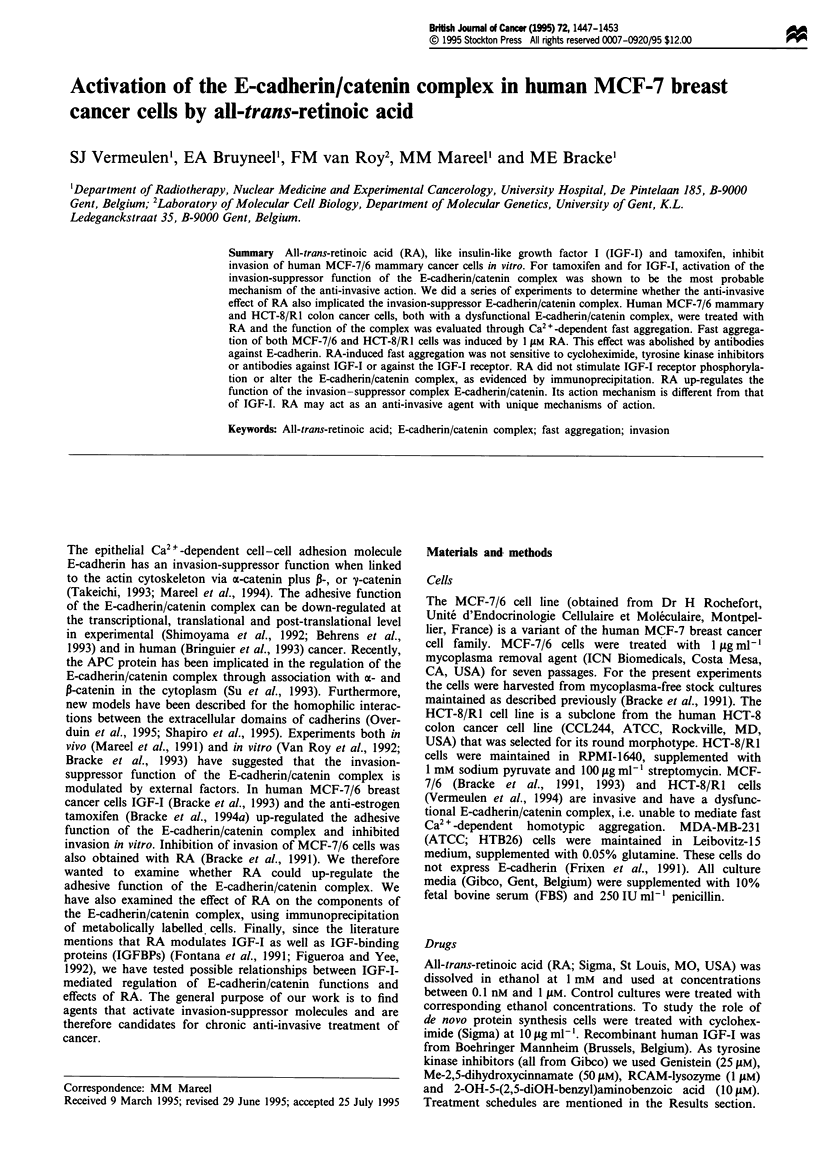
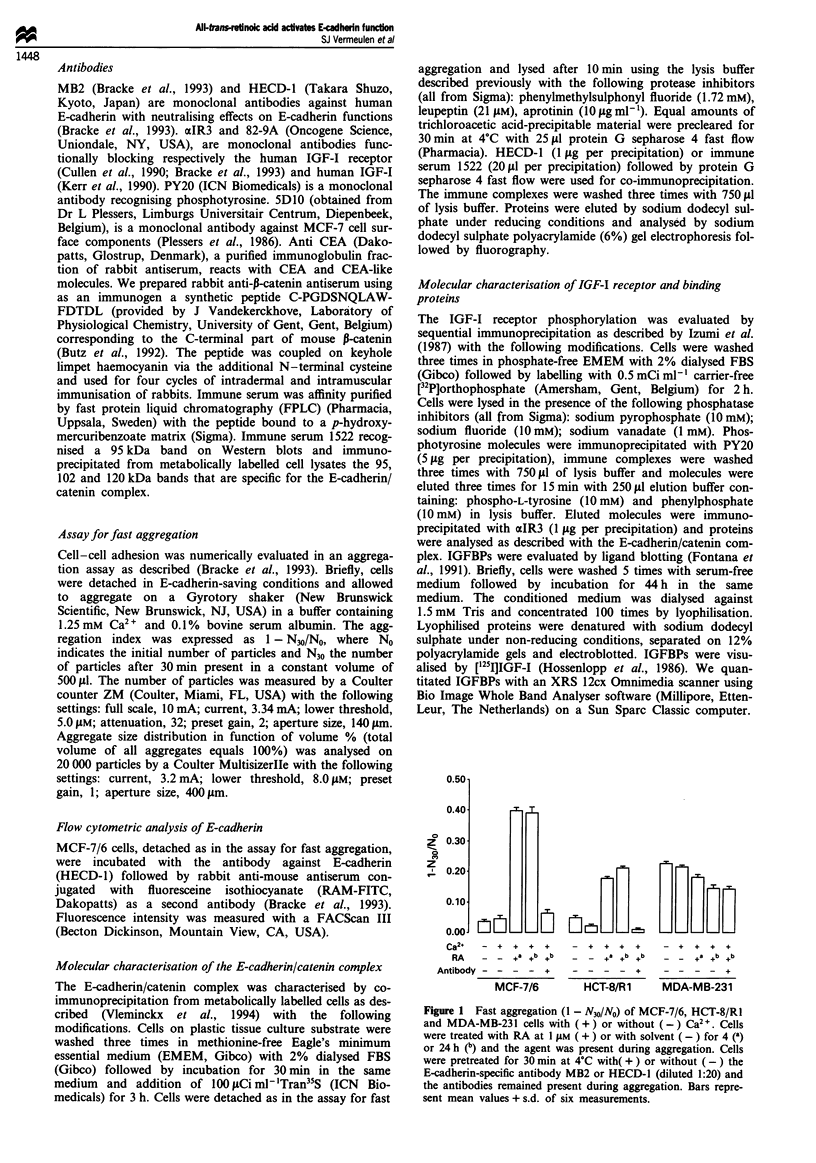
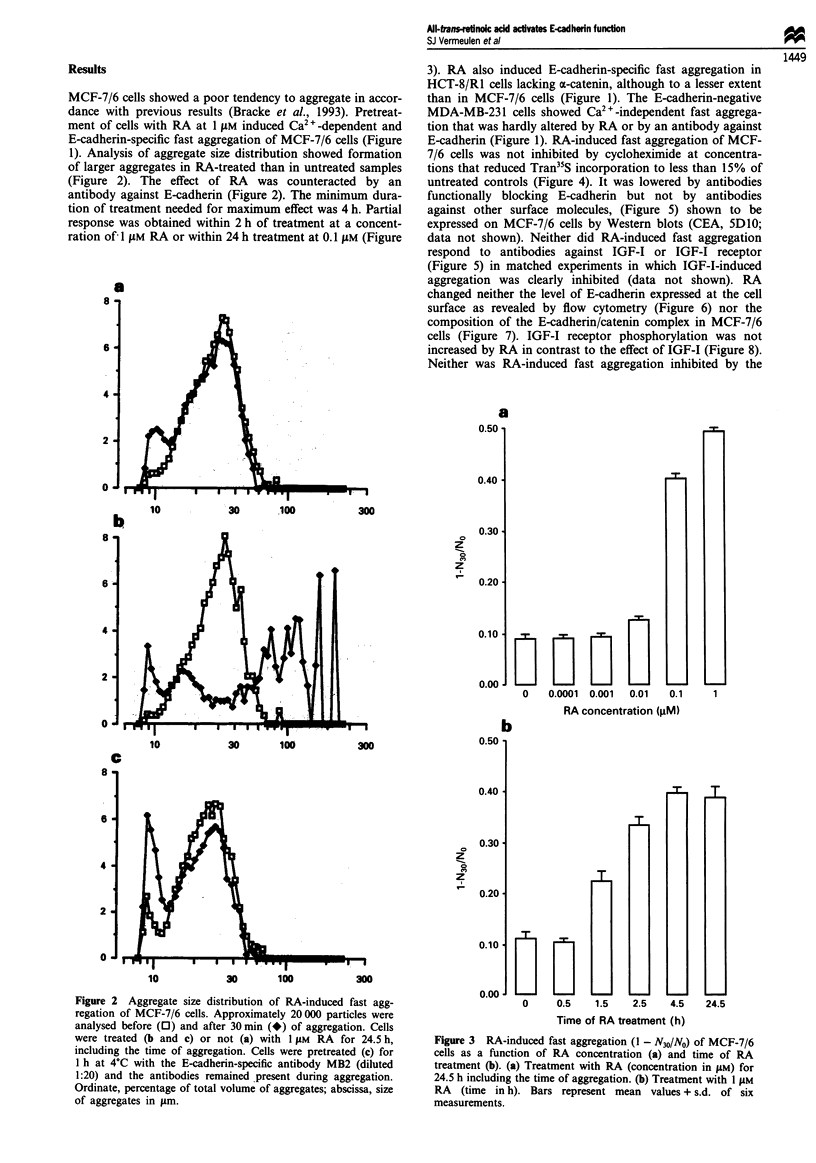
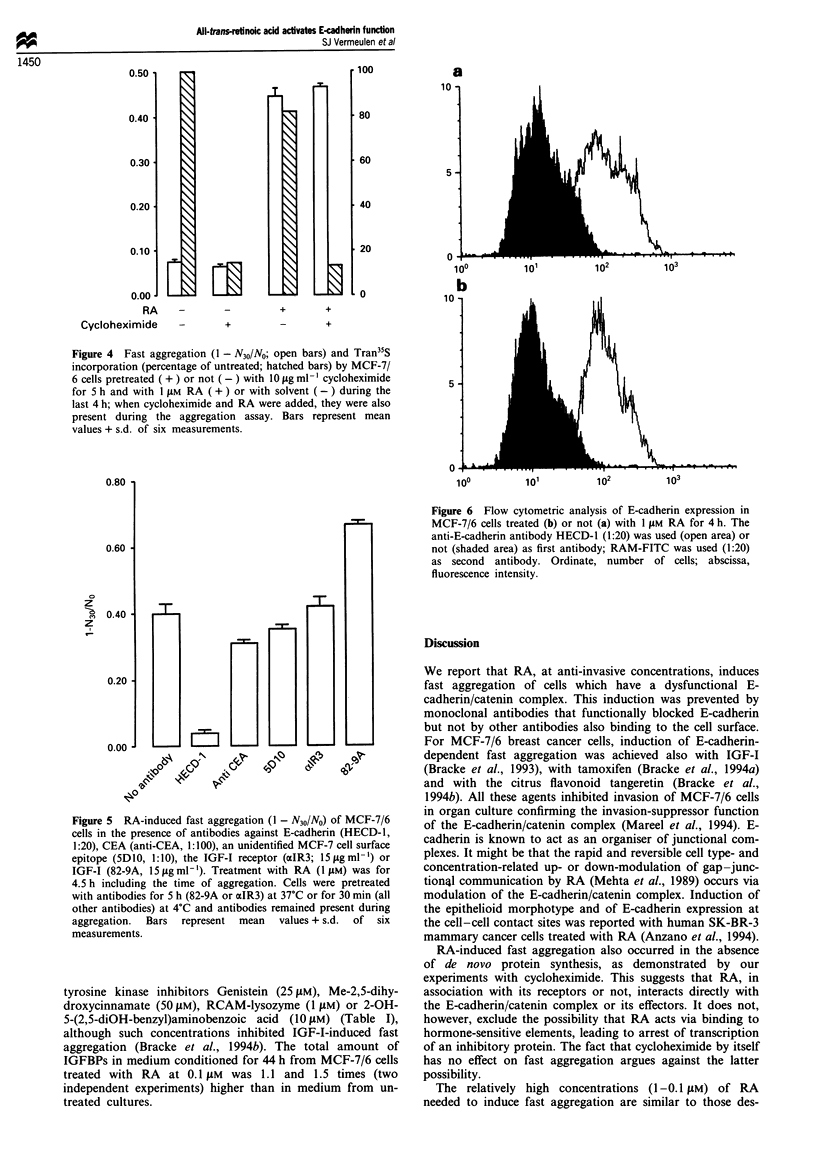
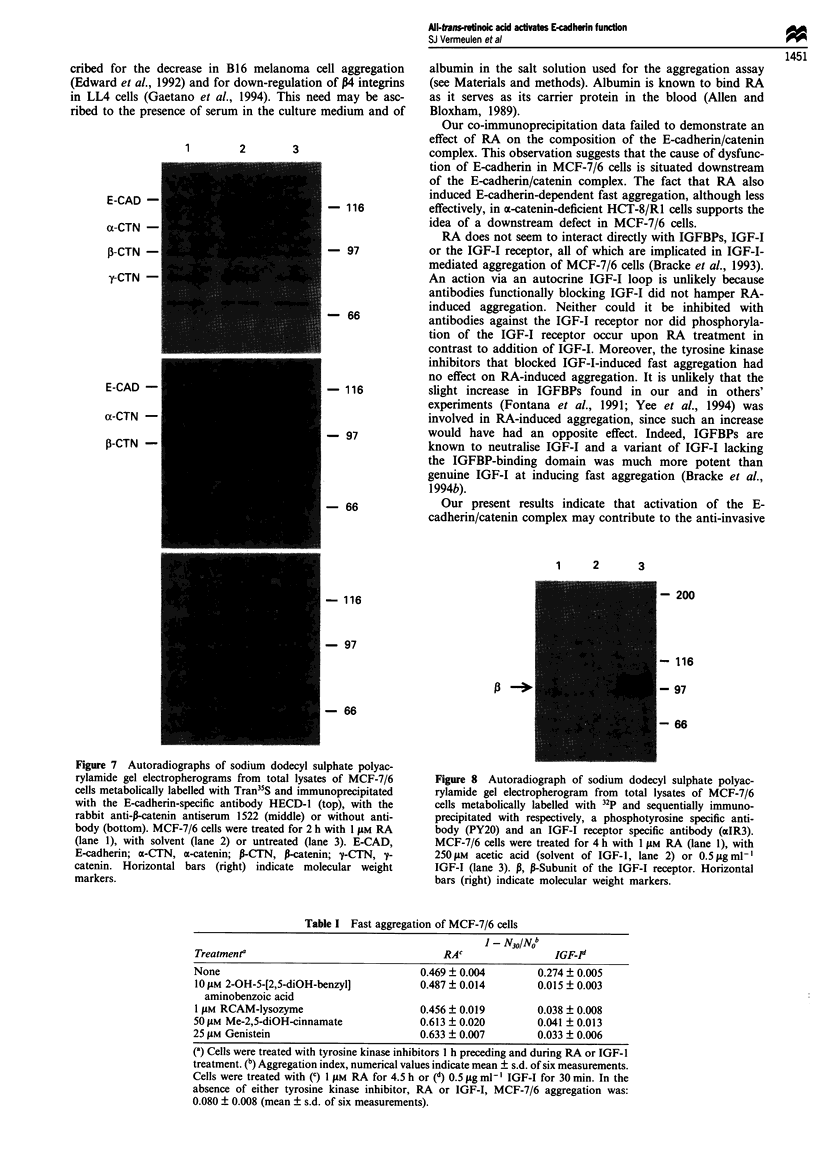
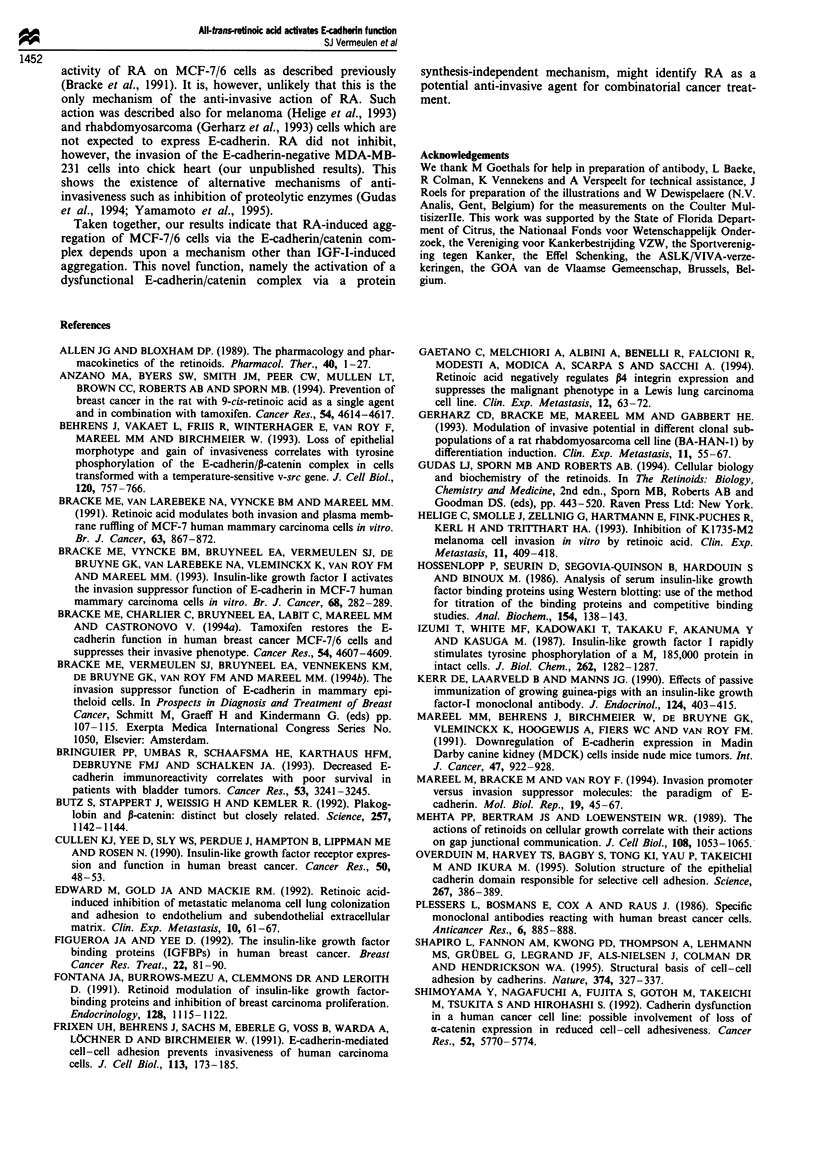
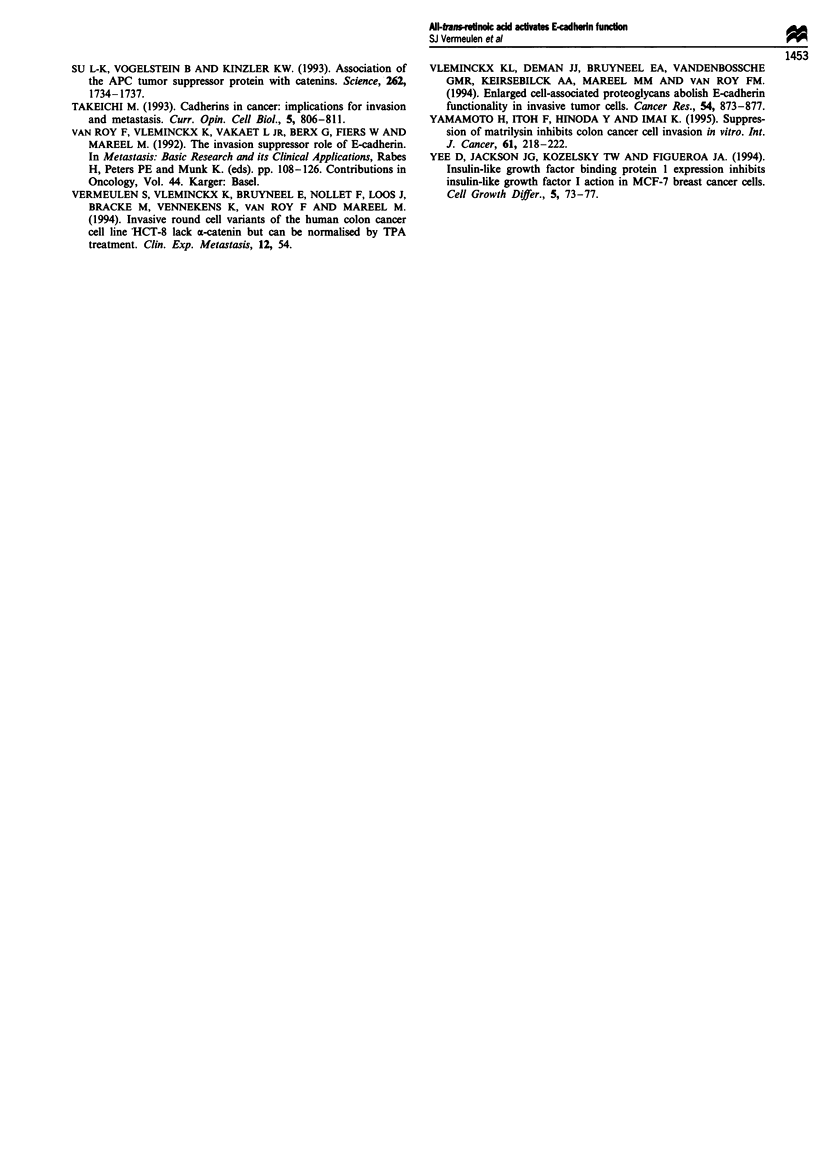
Images in this article
Selected References
These references are in PubMed. This may not be the complete list of references from this article.
- Allen J. G., Bloxham D. P. The pharmacology and pharmacokinetics of the retinoids. Pharmacol Ther. 1989;40(1):1–27. doi: 10.1016/0163-7258(89)90071-5. [DOI] [PubMed] [Google Scholar]
- Anzano M. A., Byers S. W., Smith J. M., Peer C. W., Mullen L. T., Brown C. C., Roberts A. B., Sporn M. B. Prevention of breast cancer in the rat with 9-cis-retinoic acid as a single agent and in combination with tamoxifen. Cancer Res. 1994 Sep 1;54(17):4614–4617. [PubMed] [Google Scholar]
- Behrens J., Vakaet L., Friis R., Winterhager E., Van Roy F., Mareel M. M., Birchmeier W. Loss of epithelial differentiation and gain of invasiveness correlates with tyrosine phosphorylation of the E-cadherin/beta-catenin complex in cells transformed with a temperature-sensitive v-SRC gene. J Cell Biol. 1993 Feb;120(3):757–766. doi: 10.1083/jcb.120.3.757. [DOI] [PMC free article] [PubMed] [Google Scholar]
- Bracke M. E., Charlier C., Bruyneel E. A., Labit C., Mareel M. M., Castronovo V. Tamoxifen restores the E-cadherin function in human breast cancer MCF-7/6 cells and suppresses their invasive phenotype. Cancer Res. 1994 Sep 1;54(17):4607–4609. [PubMed] [Google Scholar]
- Bracke M. E., Van Larebeke N. A., Vyncke B. M., Mareel M. M. Retinoic acid modulates both invasion and plasma membrane ruffling of MCF-7 human mammary carcinoma cells in vitro. Br J Cancer. 1991 Jun;63(6):867–872. doi: 10.1038/bjc.1991.191. [DOI] [PMC free article] [PubMed] [Google Scholar]
- Bracke M. E., Vyncke B. M., Bruyneel E. A., Vermeulen S. J., De Bruyne G. K., Van Larebeke N. A., Vleminckx K., Van Roy F. M., Mareel M. M. Insulin-like growth factor I activates the invasion suppressor function of E-cadherin in MCF-7 human mammary carcinoma cells in vitro. Br J Cancer. 1993 Aug;68(2):282–289. doi: 10.1038/bjc.1993.329. [DOI] [PMC free article] [PubMed] [Google Scholar]
- Bringuier P. P., Umbas R., Schaafsma H. E., Karthaus H. F., Debruyne F. M., Schalken J. A. Decreased E-cadherin immunoreactivity correlates with poor survival in patients with bladder tumors. Cancer Res. 1993 Jul 15;53(14):3241–3245. [PubMed] [Google Scholar]
- Butz S., Stappert J., Weissig H., Kemler R. Plakoglobin and beta-catenin: distinct but closely related. Science. 1992 Aug 21;257(5073):1142–1144. doi: 10.1126/science.257.5073.1142-a. [DOI] [PubMed] [Google Scholar]
- Cullen K. J., Yee D., Sly W. S., Perdue J., Hampton B., Lippman M. E., Rosen N. Insulin-like growth factor receptor expression and function in human breast cancer. Cancer Res. 1990 Jan 1;50(1):48–53. [PubMed] [Google Scholar]
- Edward M., Gold J. A., Mackie R. M. Retinoic acid-induced inhibition of metastatic melanoma cell lung colonization and adhesion to endothelium and subendothelial extracellular matrix. Clin Exp Metastasis. 1992 Jan;10(1):61–67. doi: 10.1007/BF00163577. [DOI] [PubMed] [Google Scholar]
- Figueroa J. A., Yee D. The insulin-like growth factor binding proteins (IGFBPs) in human breast cancer. Breast Cancer Res Treat. 1992;22(1):81–90. doi: 10.1007/BF01833336. [DOI] [PubMed] [Google Scholar]
- Fontana J. A., Burrows-Mezu A., Clemmons D. R., LeRoith D. Retinoid modulation of insulin-like growth factor-binding proteins and inhibition of breast carcinoma proliferation. Endocrinology. 1991 Feb;128(2):1115–1122. doi: 10.1210/endo-128-2-1115. [DOI] [PubMed] [Google Scholar]
- Frixen U. H., Behrens J., Sachs M., Eberle G., Voss B., Warda A., Löchner D., Birchmeier W. E-cadherin-mediated cell-cell adhesion prevents invasiveness of human carcinoma cells. J Cell Biol. 1991 Apr;113(1):173–185. doi: 10.1083/jcb.113.1.173. [DOI] [PMC free article] [PubMed] [Google Scholar]
- Gaetano C., Melchiori A., Albini A., Benelli R., Falcioni R., Modesti A., Modica A., Scarpa S., Sacchi A. Retinoic acid negatively regulates beta 4 integrin expression and suppresses the malignant phenotype in a Lewis lung carcinoma cell line. Clin Exp Metastasis. 1994 Jan;12(1):63–72. doi: 10.1007/BF01784335. [DOI] [PubMed] [Google Scholar]
- Gerharz C. D., Bracke M. E., Mareel M. M., Gabbert H. E. Modulation of invasive potential in different clonal subpopulations of a rat rhabdomyosarcoma cell line (BA-HAN-1) by differentiation induction. Clin Exp Metastasis. 1993 Jan;11(1):55–67. doi: 10.1007/BF00880066. [DOI] [PubMed] [Google Scholar]
- Helige C., Smolle J., Zellnig G., Hartmann E., Fink-Puches R., Kerl H., Tritthart H. A. Inhibition of K1735-M2 melanoma cell invasion in vitro by retinoic acid. Clin Exp Metastasis. 1993 Sep;11(5):409–418. doi: 10.1007/BF00132984. [DOI] [PubMed] [Google Scholar]
- Hossenlopp P., Seurin D., Segovia-Quinson B., Hardouin S., Binoux M. Analysis of serum insulin-like growth factor binding proteins using western blotting: use of the method for titration of the binding proteins and competitive binding studies. Anal Biochem. 1986 Apr;154(1):138–143. doi: 10.1016/0003-2697(86)90507-5. [DOI] [PubMed] [Google Scholar]
- Izumi T., White M. F., Kadowaki T., Takaku F., Akanuma Y., Kasuga M. Insulin-like growth factor I rapidly stimulates tyrosine phosphorylation of a Mr 185,000 protein in intact cells. J Biol Chem. 1987 Jan 25;262(3):1282–1287. [PubMed] [Google Scholar]
- Kerr D. E., Laarveld B., Manns J. G. Effects of passive immunization of growing guinea-pigs with an insulin-like growth factor-I monoclonal antibody. J Endocrinol. 1990 Mar;124(3):403–415. doi: 10.1677/joe.0.1240403. [DOI] [PubMed] [Google Scholar]
- Mareel M. M., Behrens J., Birchmeier W., De Bruyne G. K., Vleminckx K., Hoogewijs A., Fiers W. C., Van Roy F. M. Down-regulation of E-cadherin expression in Madin Darby canine kidney (MDCK) cells inside tumors of nude mice. Int J Cancer. 1991 Apr 1;47(6):922–928. doi: 10.1002/ijc.2910470623. [DOI] [PubMed] [Google Scholar]
- Mareel M., Bracke M., Van Roy F. Invasion promoter versus invasion suppressor molecules: the paradigm of E-cadherin. Mol Biol Rep. 1994 Jan;19(1):45–67. doi: 10.1007/BF00987321. [DOI] [PubMed] [Google Scholar]
- Mehta P. P., Bertram J. S., Loewenstein W. R. The actions of retinoids on cellular growth correlate with their actions on gap junctional communication. J Cell Biol. 1989 Mar;108(3):1053–1065. doi: 10.1083/jcb.108.3.1053. [DOI] [PMC free article] [PubMed] [Google Scholar]
- Overduin M., Harvey T. S., Bagby S., Tong K. I., Yau P., Takeichi M., Ikura M. Solution structure of the epithelial cadherin domain responsible for selective cell adhesion. Science. 1995 Jan 20;267(5196):386–389. doi: 10.1126/science.7824937. [DOI] [PubMed] [Google Scholar]
- Plessers L., Bosmans E., Cox A., Raus J. Specific monoclonal antibodies reacting with human breast cancer cells. Anticancer Res. 1986 Sep-Oct;6(5):885–888. [PubMed] [Google Scholar]
- Shapiro L., Fannon A. M., Kwong P. D., Thompson A., Lehmann M. S., Grübel G., Legrand J. F., Als-Nielsen J., Colman D. R., Hendrickson W. A. Structural basis of cell-cell adhesion by cadherins. Nature. 1995 Mar 23;374(6520):327–337. doi: 10.1038/374327a0. [DOI] [PubMed] [Google Scholar]
- Shimoyama Y., Nagafuchi A., Fujita S., Gotoh M., Takeichi M., Tsukita S., Hirohashi S. Cadherin dysfunction in a human cancer cell line: possible involvement of loss of alpha-catenin expression in reduced cell-cell adhesiveness. Cancer Res. 1992 Oct 15;52(20):5770–5774. [PubMed] [Google Scholar]
- Su L. K., Vogelstein B., Kinzler K. W. Association of the APC tumor suppressor protein with catenins. Science. 1993 Dec 10;262(5140):1734–1737. doi: 10.1126/science.8259519. [DOI] [PubMed] [Google Scholar]
- Takeichi M. Cadherins in cancer: implications for invasion and metastasis. Curr Opin Cell Biol. 1993 Oct;5(5):806–811. doi: 10.1016/0955-0674(93)90029-p. [DOI] [PubMed] [Google Scholar]
- Vleminckx K. L., Deman J. J., Bruyneel E. A., Vandenbossche G. M., Keirsebilck A. A., Mareel M. M., van Roy F. M. Enlarged cell-associated proteoglycans abolish E-cadherin functionality in invasive tumor cells. Cancer Res. 1994 Feb 15;54(4):873–877. [PubMed] [Google Scholar]
- Yamamoto H., Itoh F., Hinoda Y., Imai K. Suppression of matrilysin inhibits colon cancer cell invasion in vitro. Int J Cancer. 1995 Apr 10;61(2):218–222. doi: 10.1002/ijc.2910610213. [DOI] [PubMed] [Google Scholar]
- Yee D., Jackson J. G., Kozelsky T. W., Figueroa J. A. Insulin-like growth factor binding protein 1 expression inhibits insulin-like growth factor I action in MCF-7 breast cancer cells. Cell Growth Differ. 1994 Jan;5(1):73–77. [PubMed] [Google Scholar]



